Semantics: Word-meaning Lecture 3 Semantics
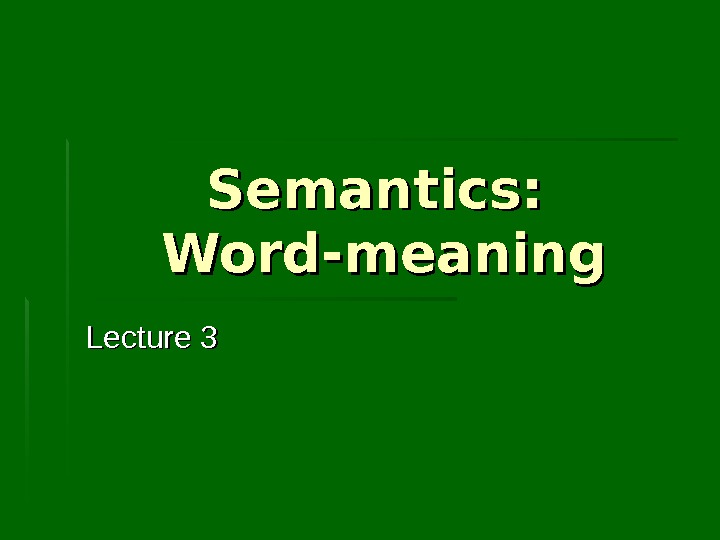
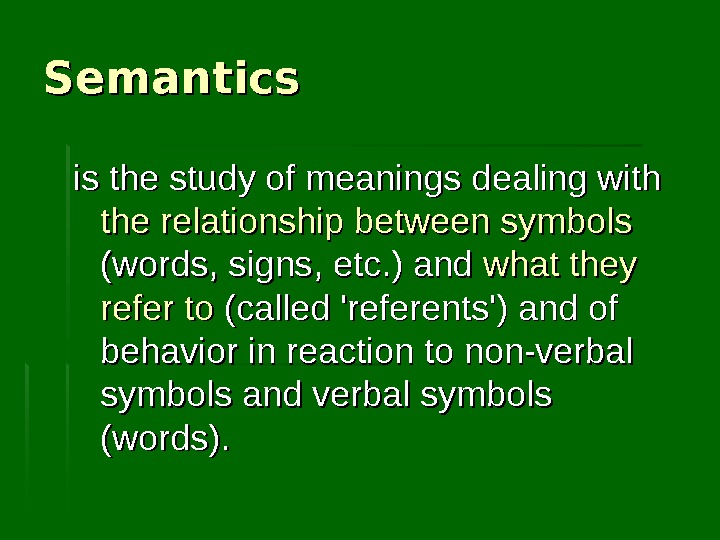
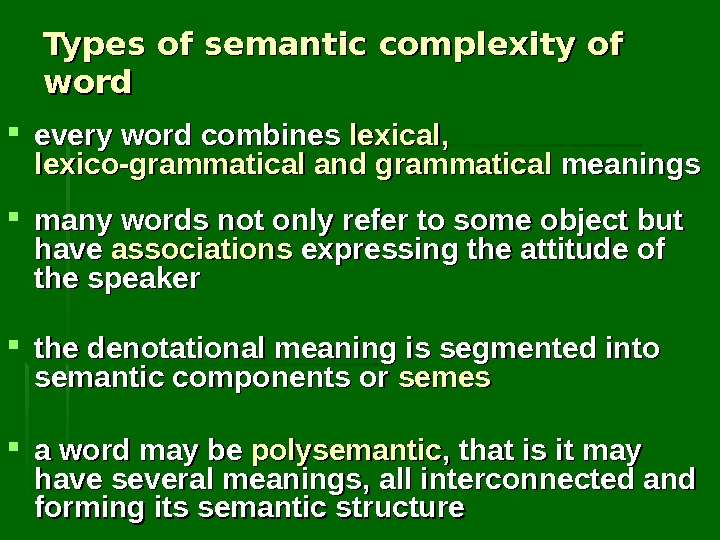
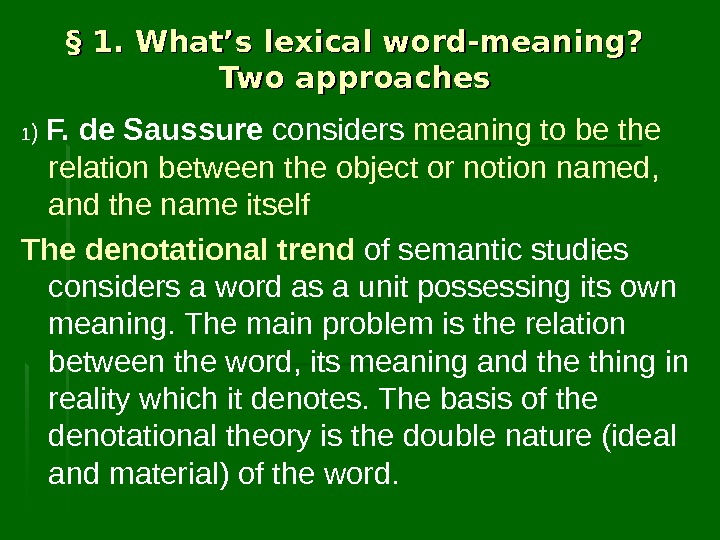
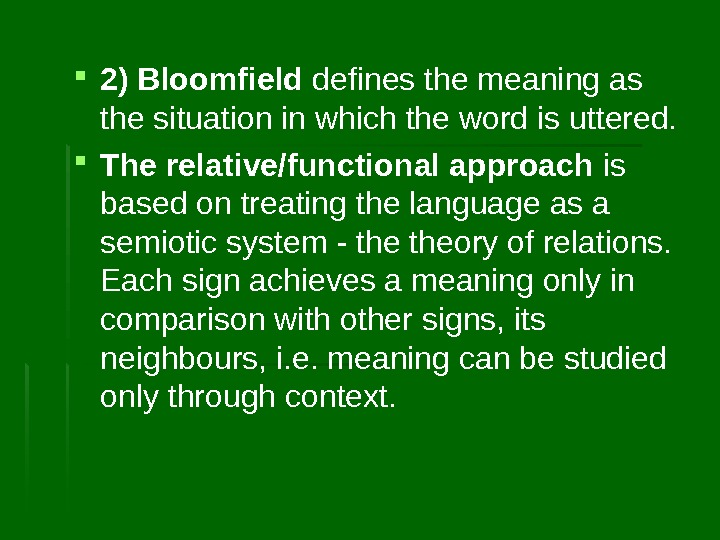
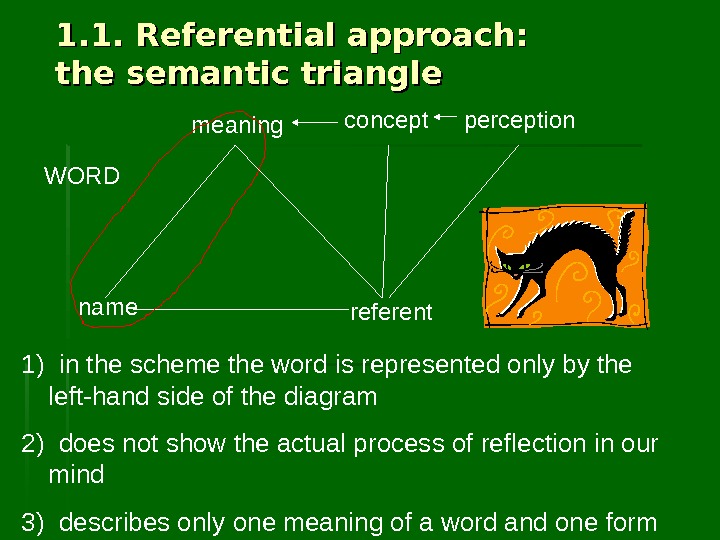
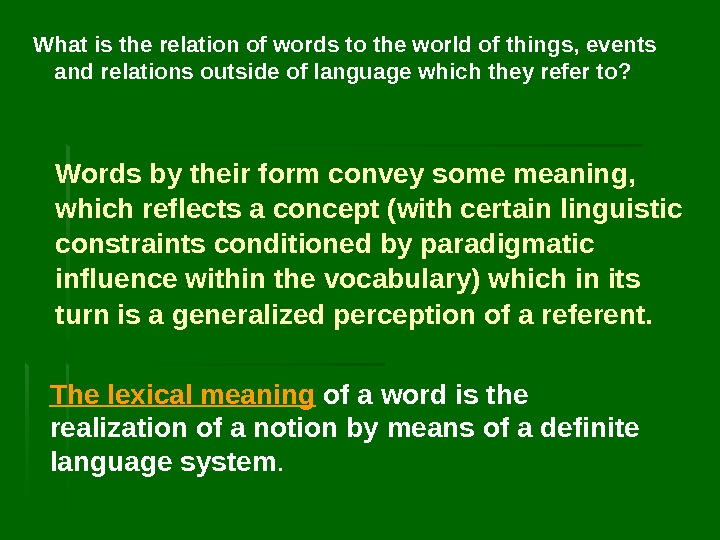
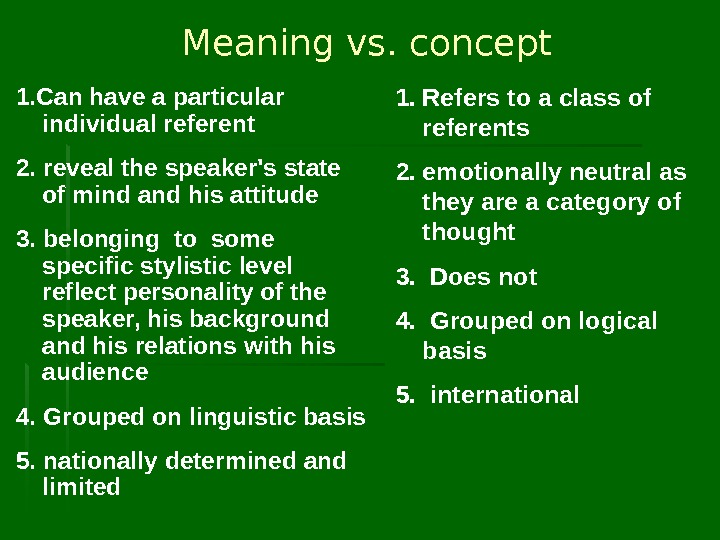
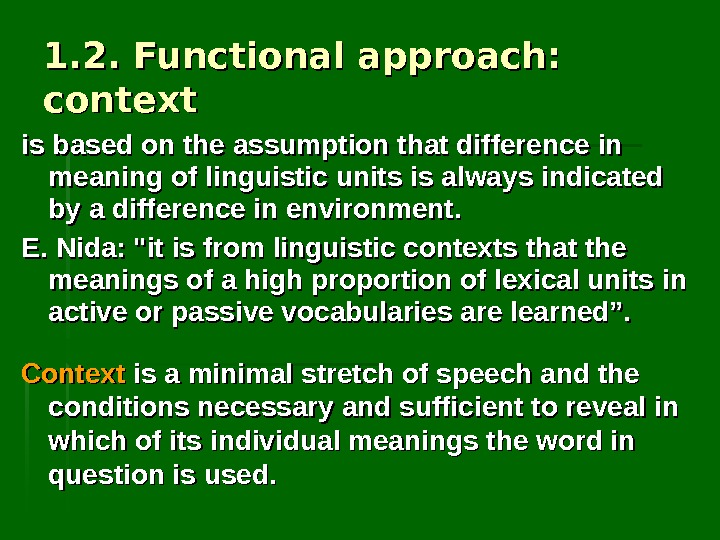
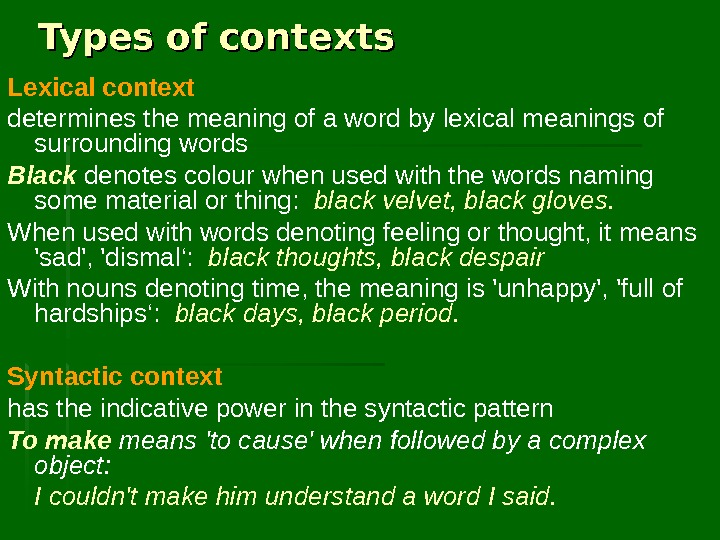
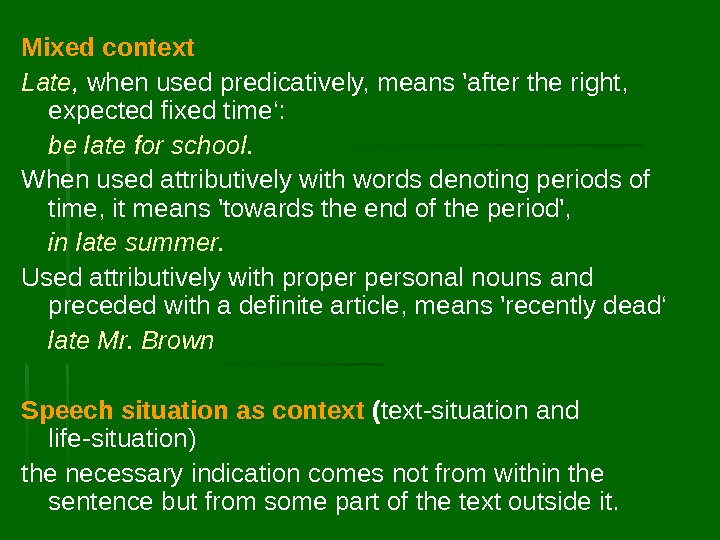
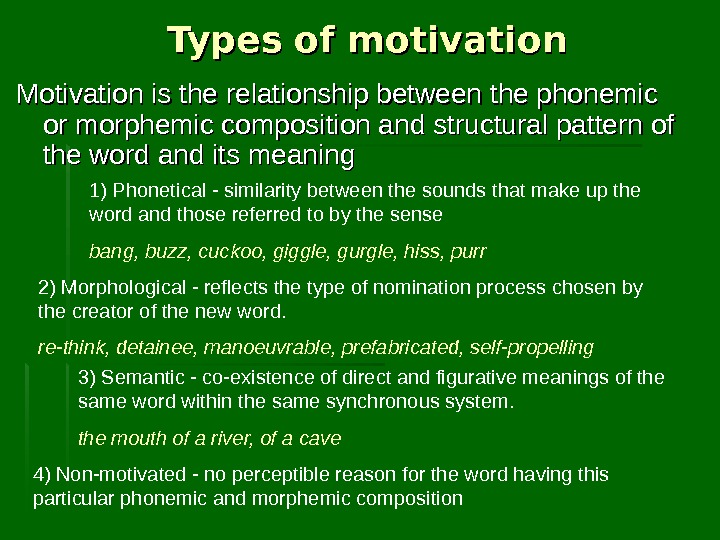
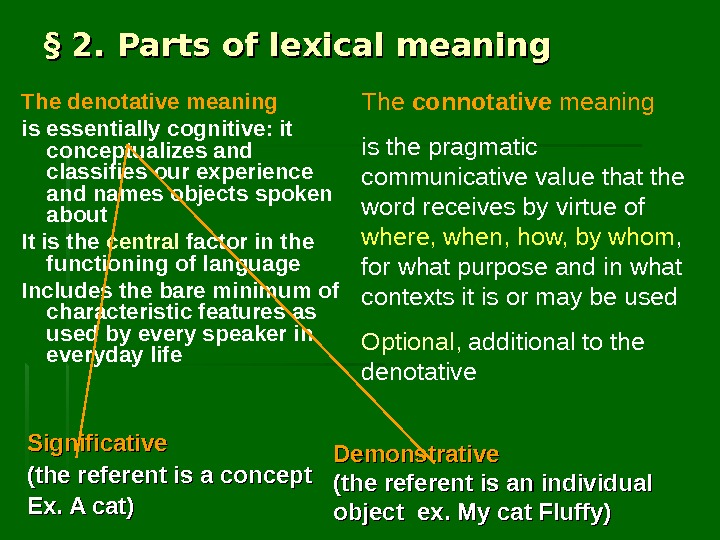
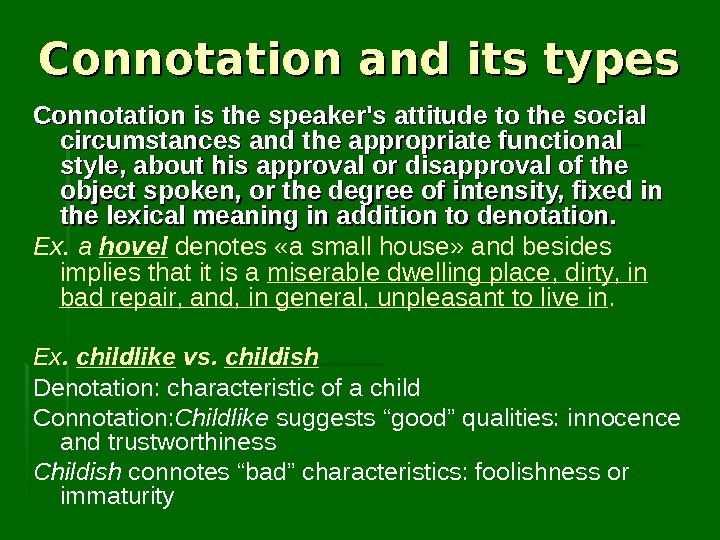


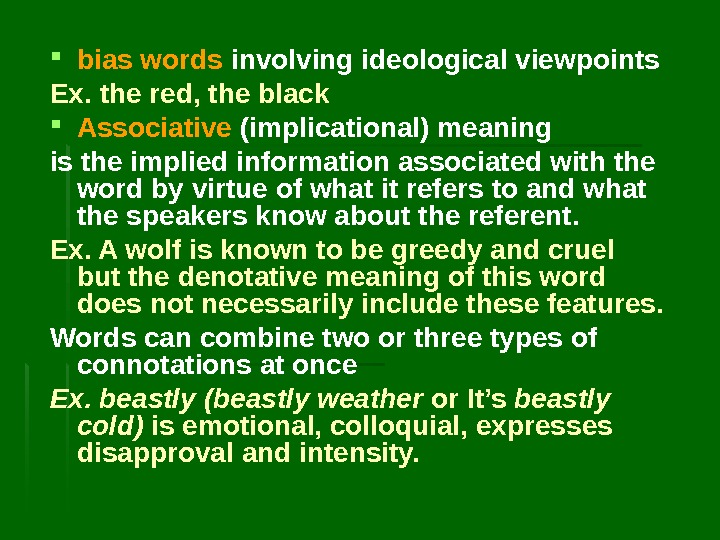
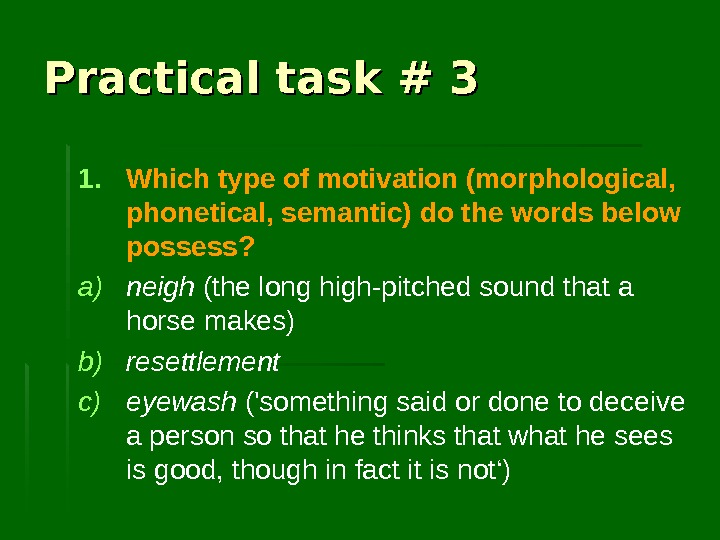
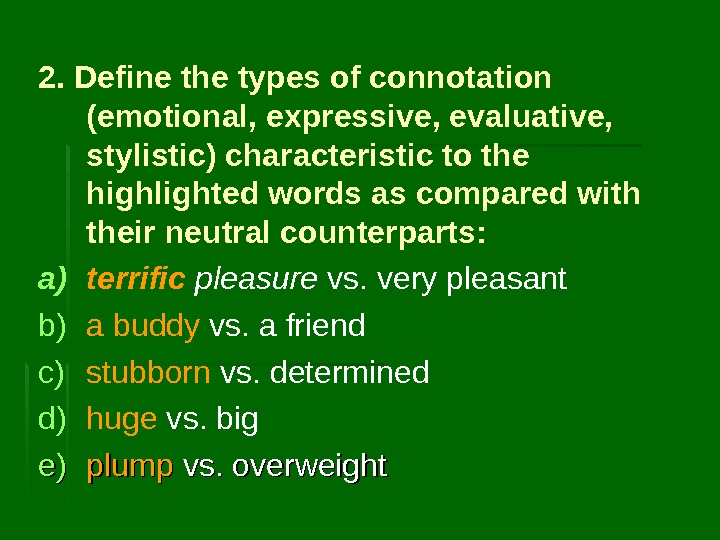
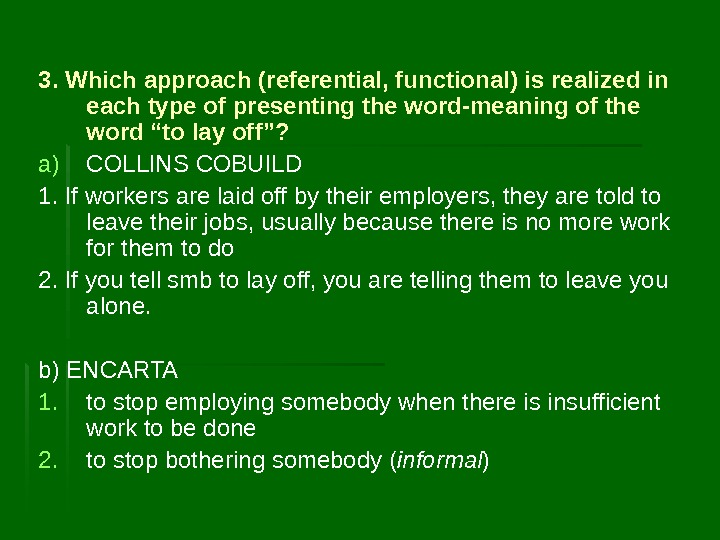
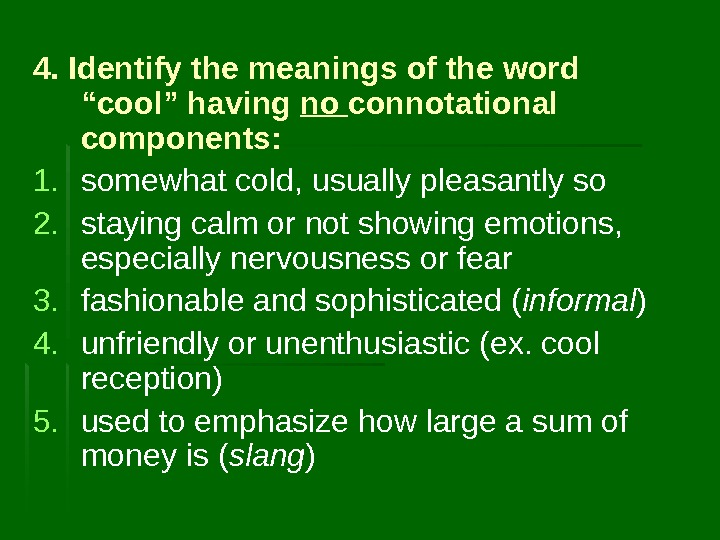
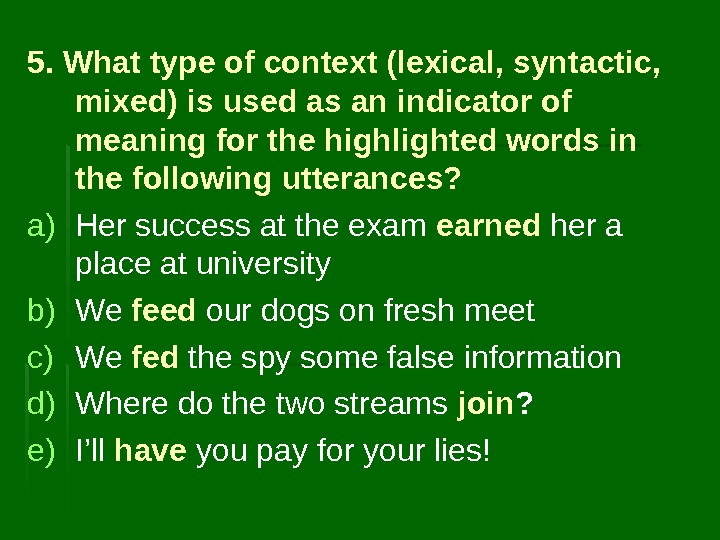
- Размер: 459.5 Кб
- Количество слайдов: 22
Описание презентации Semantics: Word-meaning Lecture 3 Semantics по слайдам
 Semantics: Word-meaning Lecture
Semantics: Word-meaning Lecture
 Semantics is the study of meanings dealing with the relationship between symbols (words, signs, etc. ) and what they refer to (called ‘referents’) and of behavior in reaction to non-verbal symbols and verbal symbols (words).
Semantics is the study of meanings dealing with the relationship between symbols (words, signs, etc. ) and what they refer to (called ‘referents’) and of behavior in reaction to non-verbal symbols and verbal symbols (words).
 Types of semantic complexity of word every word combines lexical, lexico-grammatical and grammatical meanings many words not only refer to some object but have associations expressing the attitude of the speaker the denotational meaning is segmented into semantic components or semes a word may be polysemantic , that is it may have several meanings, all interconnected and forming its semantic structure
Types of semantic complexity of word every word combines lexical, lexico-grammatical and grammatical meanings many words not only refer to some object but have associations expressing the attitude of the speaker the denotational meaning is segmented into semantic components or semes a word may be polysemantic , that is it may have several meanings, all interconnected and forming its semantic structure
 § 1. What’s lexical word-meaning? Two approaches 1 ) F. de Saussure considers meaning to be the relation between the object or notion named, and the name itself The denotational trend of semantic studies considers a word as a unit possessing its own meaning. The main problem is the relation between the word, its meaning and the thing in reality which it denotes. The basis of the denotational theory is the double nature (ideal and material) of the word.
§ 1. What’s lexical word-meaning? Two approaches 1 ) F. de Saussure considers meaning to be the relation between the object or notion named, and the name itself The denotational trend of semantic studies considers a word as a unit possessing its own meaning. The main problem is the relation between the word, its meaning and the thing in reality which it denotes. The basis of the denotational theory is the double nature (ideal and material) of the word.
 2) Bloomfield defines the meaning as the situation in which the word is uttered. The relative/functional approach is based on treating the language as a semiotic system — theory of relations. Each sign achieves a meaning only in comparison with other signs, its neighbours, i. e. meaning can be studied only through context.
2) Bloomfield defines the meaning as the situation in which the word is uttered. The relative/functional approach is based on treating the language as a semiotic system — theory of relations. Each sign achieves a meaning only in comparison with other signs, its neighbours, i. e. meaning can be studied only through context.
 1. 1. Referential approach: the semantic triangle meaning name referent 1) in the scheme the word is represented only by the left-hand side of the diagram 2) does not show the actual process of reflection in our mind 3) describes only one meaning of a word and one form concept perception WOR
1. 1. Referential approach: the semantic triangle meaning name referent 1) in the scheme the word is represented only by the left-hand side of the diagram 2) does not show the actual process of reflection in our mind 3) describes only one meaning of a word and one form concept perception WOR
 What is the relation of words to the world of things, events and relations outside of language which they refer to? Words by their form convey some meaning, which reflects a concept (with certain linguistic constraints conditioned by paradigmatic influence within the vocabulary) which in its turn is a generalized perception of a referent. The lexical meaning of a word is the realization of a notion by means of a definite language system.
What is the relation of words to the world of things, events and relations outside of language which they refer to? Words by their form convey some meaning, which reflects a concept (with certain linguistic constraints conditioned by paradigmatic influence within the vocabulary) which in its turn is a generalized perception of a referent. The lexical meaning of a word is the realization of a notion by means of a definite language system.
 Meaning vs. concept 1. Can have a particular individual referent 2. reveal the speaker’s state of mind and his attitude 3. belonging to some specific stylistic level reflect personality of the speaker, his background and his relations with his audience 4. Grouped on linguistic basis 5. nationally determined and limited 1. Refers to a class of referents 2. emotionally neutral as they are a category of thought 3. Does not 4. Grouped on logical basis 5. international
Meaning vs. concept 1. Can have a particular individual referent 2. reveal the speaker’s state of mind and his attitude 3. belonging to some specific stylistic level reflect personality of the speaker, his background and his relations with his audience 4. Grouped on linguistic basis 5. nationally determined and limited 1. Refers to a class of referents 2. emotionally neutral as they are a category of thought 3. Does not 4. Grouped on logical basis 5. international
 1. 2. Functional approach: context is based on the assumption that difference in meaning of linguistic units is always indicated by a difference in environment. E. Nida: «it is from linguistic contexts that the meanings of a high proportion of lexical units in active or passive vocabularies are learned”. Context is a minimal stretch of speech and the conditions necessary and sufficient to reveal in which of its individual meanings the word in question is used.
1. 2. Functional approach: context is based on the assumption that difference in meaning of linguistic units is always indicated by a difference in environment. E. Nida: «it is from linguistic contexts that the meanings of a high proportion of lexical units in active or passive vocabularies are learned”. Context is a minimal stretch of speech and the conditions necessary and sufficient to reveal in which of its individual meanings the word in question is used.
 Types of contexts Lexical context determines the meaning of a word by lexical meanings of surrounding words Black denotes colour when used with the words naming some material or thing: black velvet, black gloves. When used with words denoting feeling or thought, it means ‘sad’, ‘dismal‘: black thoughts, black despair With nouns denoting time, the meaning is ‘unhappy’, ‘full of hardships‘: black days, black period. Syntactic context has the indicative power in the syntactic pattern To make means ‘to cause’ when followed by a complex object: I couldn’t make him understand a word I said.
Types of contexts Lexical context determines the meaning of a word by lexical meanings of surrounding words Black denotes colour when used with the words naming some material or thing: black velvet, black gloves. When used with words denoting feeling or thought, it means ‘sad’, ‘dismal‘: black thoughts, black despair With nouns denoting time, the meaning is ‘unhappy’, ‘full of hardships‘: black days, black period. Syntactic context has the indicative power in the syntactic pattern To make means ‘to cause’ when followed by a complex object: I couldn’t make him understand a word I said.
 Mixed context Late , when used predicatively, means ‘after the right, expected fixed time‘: be late for school. When used attributively with words denoting periods of time, it means ‘towards the end of the period’, in late summer. Used attributively with proper personal nouns and preceded with a definite article, means ‘recently dead‘ late Mr. Brown Speech situation as context ( text-situation and life-situation) the necessary indication comes not from within the sentence but from some part of the text outside it.
Mixed context Late , when used predicatively, means ‘after the right, expected fixed time‘: be late for school. When used attributively with words denoting periods of time, it means ‘towards the end of the period’, in late summer. Used attributively with proper personal nouns and preceded with a definite article, means ‘recently dead‘ late Mr. Brown Speech situation as context ( text-situation and life-situation) the necessary indication comes not from within the sentence but from some part of the text outside it.
 Types of motivation Motivation is the relationship between the phonemic or morphemic composition and structural pattern of the word and its meaning 1) Phonetical — similarity between the sounds that make up the word and those referred to by the sense bang, buzz, cuckoo, giggle, gurgle, hiss, purr 2) Morphological — reflects the type of nomination process chosen by the creator of the new word. re-think, detainee, manoeuvrable, prefabricated, self-propelling 3) Semantic — co-existence of direct and figurative meanings of the same word within the same synchronous system. the mouth of a river, of a cave 4) Non-m о tivated — no perceptible reason for the word having this particular phonemic and morphemic composition
Types of motivation Motivation is the relationship between the phonemic or morphemic composition and structural pattern of the word and its meaning 1) Phonetical — similarity between the sounds that make up the word and those referred to by the sense bang, buzz, cuckoo, giggle, gurgle, hiss, purr 2) Morphological — reflects the type of nomination process chosen by the creator of the new word. re-think, detainee, manoeuvrable, prefabricated, self-propelling 3) Semantic — co-existence of direct and figurative meanings of the same word within the same synchronous system. the mouth of a river, of a cave 4) Non-m о tivated — no perceptible reason for the word having this particular phonemic and morphemic composition
 § 2. Parts of lexical meaning The denotative meaning is essentially cognitive: it conceptualizes and classifies our experience and names objects spoken about It is the central factor in the functioning of language Includes the bare minimum of characteristic features as used by every speaker in everyday life The connotative meaning is the pragmatic communicative value that the word receives by virtue of where, when, how, by whom , for what purpose and in what contexts it is or may be used Optional, additional to the denotative Signifi сс ative (the referent is a concept Ex. A cat) Dem оо nstrative (the referent is an individual object ex. My cat Fluffy)
§ 2. Parts of lexical meaning The denotative meaning is essentially cognitive: it conceptualizes and classifies our experience and names objects spoken about It is the central factor in the functioning of language Includes the bare minimum of characteristic features as used by every speaker in everyday life The connotative meaning is the pragmatic communicative value that the word receives by virtue of where, when, how, by whom , for what purpose and in what contexts it is or may be used Optional, additional to the denotative Signifi сс ative (the referent is a concept Ex. A cat) Dem оо nstrative (the referent is an individual object ex. My cat Fluffy)
 Connotation and its types Connotation is the speaker’s attitude to the social circumstances and the appropriate functional style, about his approval or disapproval of the object spoken, or the degree of intensity, fixed in the lexical meaning in addition to denotation. Ex. a hovel denotes «a small house» and besides implies that it is a miserable dwelling place, dirty, in bad repair, and, in general, unpleasant to live in. Ex. childlike vs. childish Denotation: characteristic of a child Connotation: Childlike suggests “good” qualities: innocence and trustworthiness Childish connotes “bad” characteristics: foolishness or immaturity
Connotation and its types Connotation is the speaker’s attitude to the social circumstances and the appropriate functional style, about his approval or disapproval of the object spoken, or the degree of intensity, fixed in the lexical meaning in addition to denotation. Ex. a hovel denotes «a small house» and besides implies that it is a miserable dwelling place, dirty, in bad repair, and, in general, unpleasant to live in. Ex. childlike vs. childish Denotation: characteristic of a child Connotation: Childlike suggests “good” qualities: innocence and trustworthiness Childish connotes “bad” characteristics: foolishness or immaturity
 stylistic connotation Is an association with the situation in which the word is uttered, the social circumstances (formal, familiar, etc. ), the social relationships between the interlocutors (polite, rough), the type and purpose of communication (learned, poetic, official, etc. ) Ex. horse – steed, to discharge/dismiss — to fire – to give a sack emotive connotation is acquired by the word as a result of its frequent use in contexts corresponding to emotional situations or because the referent named in the denotative meaning is associated with emotions. For example, the verb means Ex. dog – doggie; beseech: ‘to ask eagerly and also anxiously’
stylistic connotation Is an association with the situation in which the word is uttered, the social circumstances (formal, familiar, etc. ), the social relationships between the interlocutors (polite, rough), the type and purpose of communication (learned, poetic, official, etc. ) Ex. horse – steed, to discharge/dismiss — to fire – to give a sack emotive connotation is acquired by the word as a result of its frequent use in contexts corresponding to emotional situations or because the referent named in the denotative meaning is associated with emotions. For example, the verb means Ex. dog – doggie; beseech: ‘to ask eagerly and also anxiously’
 evaluative connotation expresses approval or disapproval. Ex. famous/well-known — notorious Magic=witchcraft=sorcery — art and power of controlling events by occult supernatural means magic has glamorous attractive connotations witchcraft and sorcery have rather sinister associations expressive or intensifying connotation exaggerates real qualities of a referent Ex. splendid, superb, fantastic, beastly, etc. are used colloquially as terms of exaggeration
evaluative connotation expresses approval or disapproval. Ex. famous/well-known — notorious Magic=witchcraft=sorcery — art and power of controlling events by occult supernatural means magic has glamorous attractive connotations witchcraft and sorcery have rather sinister associations expressive or intensifying connotation exaggerates real qualities of a referent Ex. splendid, superb, fantastic, beastly, etc. are used colloquially as terms of exaggeration
 bias words involving ideological viewpoints Ex. the red, the black Associative (implicational) meaning is the implied information associated with the word by virtue of what it refers to and what the speakers know about the referent. Ex. A wolf is known to be greedy and cruel but the denotative meaning of this word does not necessarily include these features. Words can combine two or three types of connotations at once Ex. beastly (beastly weather or It’s beastly cold) is emotional, colloquial, expresses disapproval and intensity.
bias words involving ideological viewpoints Ex. the red, the black Associative (implicational) meaning is the implied information associated with the word by virtue of what it refers to and what the speakers know about the referent. Ex. A wolf is known to be greedy and cruel but the denotative meaning of this word does not necessarily include these features. Words can combine two or three types of connotations at once Ex. beastly (beastly weather or It’s beastly cold) is emotional, colloquial, expresses disapproval and intensity.
 Practical task # 3 1. Which type of motivation (morphological, phonetical, semantic) do the words below possess? a) neigh ( the long high-pitched sound that a horse makes ) b) resettlement c) eyewash (‘something said or done to deceive a person so that he thinks that what he sees is good, though in fact it is not‘)
Practical task # 3 1. Which type of motivation (morphological, phonetical, semantic) do the words below possess? a) neigh ( the long high-pitched sound that a horse makes ) b) resettlement c) eyewash (‘something said or done to deceive a person so that he thinks that what he sees is good, though in fact it is not‘)
 2. Define the types of connotation (emotional, expressive, evaluative, stylistic) characteristic to the highlighted words as compared with their neutral counterparts: a) terrific pleasure vs. very pleasant b) a buddy vs. a friend c) stubborn vs. d etermined d) huge vs. big e)e) plump vs. overweight
2. Define the types of connotation (emotional, expressive, evaluative, stylistic) characteristic to the highlighted words as compared with their neutral counterparts: a) terrific pleasure vs. very pleasant b) a buddy vs. a friend c) stubborn vs. d etermined d) huge vs. big e)e) plump vs. overweight
 3. Which approach (referential, functional) is realized in each type of presenting the word-meaning of the word “to lay off”? a) COLLINS COBUILD 1. If workers are laid off by their employers, they are told to leave their jobs, usually because there is no more work for them to do 2. If you tell smb to lay off, you are telling them to leave you alone. b) ENCARTA 1. to stop employing somebody when there is insufficient work to be done 2. to stop bothering somebody ( informal )
3. Which approach (referential, functional) is realized in each type of presenting the word-meaning of the word “to lay off”? a) COLLINS COBUILD 1. If workers are laid off by their employers, they are told to leave their jobs, usually because there is no more work for them to do 2. If you tell smb to lay off, you are telling them to leave you alone. b) ENCARTA 1. to stop employing somebody when there is insufficient work to be done 2. to stop bothering somebody ( informal )
 4. Identify the meanings of the word “cool” having no connotational components: 1. somewhat cold, usually pleasantly so 2. staying calm or not showing emotions, especially nervousness or fear 3. fashionable and sophisticated ( informal ) 4. unfriendly or unenthusiastic (ex. cool reception) 5. used to emphasize how large a sum of money is ( slang )
4. Identify the meanings of the word “cool” having no connotational components: 1. somewhat cold, usually pleasantly so 2. staying calm or not showing emotions, especially nervousness or fear 3. fashionable and sophisticated ( informal ) 4. unfriendly or unenthusiastic (ex. cool reception) 5. used to emphasize how large a sum of money is ( slang )
 5. What type of context (lexical, syntactic, mixed) is used as an indicator of meaning for the highlighted words in the following utterances? a) Her success at the exam earned her a place at university b) We feed our dogs on fresh meet c) We fed the spy some false information d) Where do the two streams join ? e) I’ll have you pay for your lies!
5. What type of context (lexical, syntactic, mixed) is used as an indicator of meaning for the highlighted words in the following utterances? a) Her success at the exam earned her a place at university b) We feed our dogs on fresh meet c) We fed the spy some false information d) Where do the two streams join ? e) I’ll have you pay for your lies!
